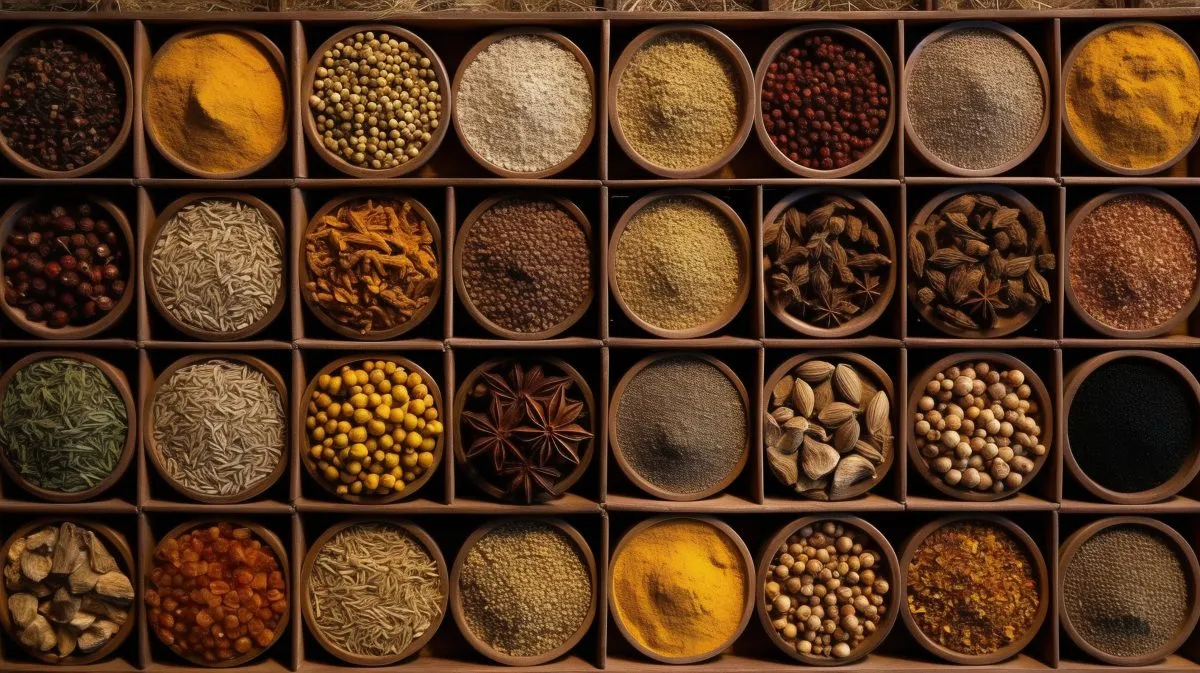
The Exoticism of SpiceSeptember 17th, 2023Wunderkammers confronted visitors with objects that were not only curious, rare, and precious, but also informative about their owners: how they viewed themselves and what their aspirations were. —Virginie Spenlé, Savagery and CivilizationIf you’ve seen any films in the franchises of Indiana Jones, Tomb Raider, The Mummy, or National Treasure, then you’re already familiar with the aesthetic appeal of the Wunderkammer: collections of curiosities, often from distant lands and vanished cultures, hoarded by the wealthy and well-traveled. Scenes in these franchises are draped with exotic artifacts and bizarre trinkets of this sort—skeletons, dusty bottles, taxidermy, religious icons, regalia, relics, and weapons, among them. For centuries, dominant societies have been captivated by oddities like these carried across the ocean by colonial pillagers. The notion of the Wunderkammer came to mind recently when I finished building a small cabinet for another kind of curiosity: spices. “What does spicy mean to you?” I asked my 12-year-old niece. She was three bites into her first experience with Chipotle and had just used the s-word to describe her burrito, which contained only chicken, white rice, cheese, lettuce, and sour cream. I rephrased the question, “do you mean spicy like hot sauce, or just that it has a lot of flavor?” She didn’t know how to respond, and I didn’t press the matter. I was familiar with the discrepancy—my Cuban mother routinely harangued my Irish father for what she considered misuse of the word. In Miami during the 1960s, when my parents came of age, spices such as dried garlic, onion, cumin, and anything chili-related were emblematic of the immigrants and asylum-seekers flooding in from Latin America; it was a mark of racially antipathetic group solidarity for my father’s family to stick to good old-fashioned salt and pepper. The spice cabinet in his childhood kitchen contained at most eight or nine small jars so rarely used that they would be many years expired by the time they were discarded. Even then, most of what they termed spices were actually herbs—oregano, parsley, basil—and found more commonly in European cuisines than in those of the tropics or the global south. When my father met my mother, she brought another kind of spice into his life. He grew up somewhat insulated from the burgeoning Latin American culture in Dade County, learning to rebuild cars and joining the early ranks of The National Association for Stock Car Auto Racing, otherwise known as NASCAR (a sport that is still not known for its diversity). My mother didn’t match that crowd, and that’s what my father liked about her. She stood out. She had unique tastes in music and fashion, and boy, could she cook. His mundane, monochromatic life suddenly had color, zest—spice. That spice was different still from the spiciness that my white, racially prejudiced grandfather would have equated with certain Latina women. My grandfather would never have courted a Latin American woman, and he didn’t care much for the men either. The same held true for their music, language, fashion, and food. Nevertheless, he managed to leave enough wiggle room between his sanctions to objectify them. Ogling and catcalling “spicy” Latina women was a gratifying experience for my grandfather, despite his negative regard for their basic humanity. Exotic products, by contrast, usually alluded to a prince’s colonial achievements or ambition, referring vaguely to unsophisticated, remote lands as opposed to ‘civilized’ Europe. Only rarely did such exotica depict the actual activities of colonizers in a non-European sphere. —Virginie Spenlé, Savagery and CivilizationThe utilities and conceptions of spices and spiciness vary wildly between entities and eras, but they almost always play a distinguishing role between nationalities, ethnicities, and classes. For my mother, the possession and skilled use of spices indicated a greater level of sophistication and taste in our family than in that of the common mac-n-cheese monger; for my father’s parents, they indicated roughly the opposite. For the nobility of centuries and millennia past, spices “were a last opportunity to show the nobleman as belonging to a class apart” (Turner, 2004, p. 155). Even Ramses II, who died in 1224 B.C.E., had his not-long-deceased nose stuffed with peppercorns from India. This parting gesture affirmed both his deified class and cultural eminence—the spice was so rare in Egypt that historians are still uncertain how it made it from India to his sinus cavity in the first place (Turner, 2004, p. 145-146). In addition to distinguishing the wealthy dead from the poor dead, spices were used to protect the wealthy living from death itself. Spices and herbs as medicine were big business for apothecaries of antiquity and the Middle Ages—as they remain today, in an updated sense. From one era to the next, “spices and medicines were effectively one and the same” and “there was scarcely an illness spices were not believed to cure” (Turner, 2004, pg. 159, 164). When Queen Elizabeth I encountered public spaces, she was outfitted with a spice-filled pomander and spice-perfumed gloves to protect herself from the potential pestilence of the poor. A more brazen use of spice as a barrier was the beak-like mask worn by Elizabethan and Jacobean doctors in the presence of plague-ridden peasants. The beak of the mask was filled with aromatic spices and herbs, which were thought to defend the wearer from their diseased patients (Turner, 2004, p. 179, 180). Each of these examples—material and metaphorical, spanning millennia and the globe—share a common ancestry: the exoticism of spice. Although it seems that the Other is sometimes valued, as with exoticism, it is done in a stereotypical, reassuring fashion that serves to comfort the Self in its feeling of superiority. —J. Staszak, Other/OthernessAmerican grocery stores commonly have specialty sections wherein foods common to Latin American, Hispanic, Asian, and Jewish cuisines—not exhaustively, but most commonly—are grouped together. In my local store, this is where you’ll find a sizeable offering of salsas. Meanwhile, if you’re looking for pasta sauce, you’ll find it in the same aisle as the tomatoes—right next to them, in fact. Salsa and pasta sauce are both tomato-based sauces and are both strongly associated with cuisines from other countries; why, then, is one segregated from the rest of the tomato products while the other is not? It seems an obvious answer that since there is a section for “foreign” foods, including Hispanic, it makes organizational sense to place the salsa there. That tenuous logic falls apart when you consider that the ethnic roots of pasta sauce are considerably farther flung than our neighboring Mexico, from which we are only separated by an imaginary border, whereas there’s an ocean, a peninsula, and a few islands between the U.S. and Italy. This typical American grocery store experience illustrates the self-defining factors that truly separate these foods: Eurocentrism and white normativism. And yes, it applies to spices, too. Between the salsa and the tortillas (which themselves belong in the bread aisle with the flatbreads and spinach wraps) are a two-by-four foot pegboard and a few shelves containing everything from whole dried anchos to star anise, cumin, ground chipotle, and the Sazón Goya con Azafran that my mother used in our arroz amarillo con pollo when I was a child. Several of these spices are offered in toned-down, whitewashed packaging in the general spice aisle, but the Badia and Goya brands—and the cellophane packets with paper tags in the color of the Mexican flag—all belong in what I overheard a southwest Virginia Wal-Mart employee once refer to as “that there ethnic section.” The Herbs de Provence are good where they are, but the El Guapo brand anis estrella—that’s on aisle twelve. These examples of othering and exoticism have the effect—whether intended or not—of preserving the culturally dominant group’s position over its subordinates. To further the example, African spices and foods aren’t to be found in another section—they’re not even in the store. This separation acts as a means of keeping those groups deemed less desirable—Hispanic, Asian, Jewish—in the position of outsiders. The very word exotic comes from the Greek exo, meaning outside. In effect, every material and metaphorical instance of spice in white American culture places the object of reference in a sort of Wunderkammer: the spicy food, spicy woman, medicinal spices, and the spices themselves can all be found on various shelves, as the playthings won of a conquest. |









